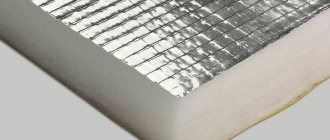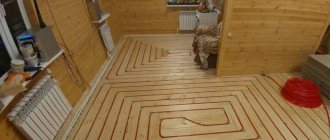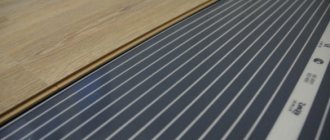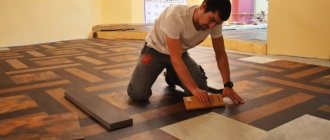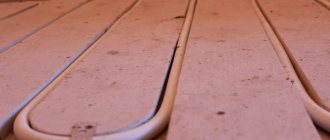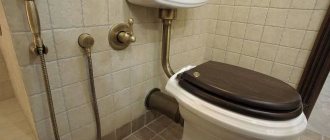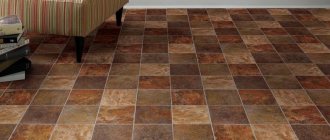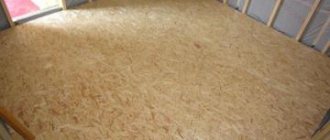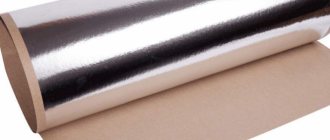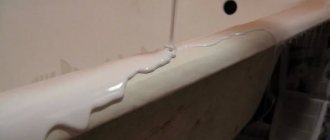Here you will learn:
- Purpose of the substrate under the laminate
- Advantages of a quality substrate
- Which substrate to choose for laminate
- Installation of the substrate
Heated floors are often preferred to radiators because they are better than radiators: convection currents rise from bottom to top, and even with very hot radiators, the floor in the room can remain cold.
A water floor does not radiate heat as evenly as an electric one: the cable heats up equally along its entire length, and the coolant in the pipe cools as it moves away from the boiler. But laying in a spiral (otherwise known as a “snail”) compensates for this disadvantage: the hot part of the pipe runs along the walls, the cold part ends up in the center of the room, and the center is objectively warmer.
In order for the thermal efficiency of the floor to be high, it is not enough to ensure a suitable temperature of the pipeline itself. It is important that all layers located above the pipe (screed, substrate, coating itself) have high thermal conductivity. Otherwise, the coating will warm up from the inside instead of radiating heat into the room.
On the base side, it is necessary to lay insulation and a reflective layer (foil or foil-coated materials are used for this purpose). Otherwise, some of the heat from the pipes will go down, not up, and this will also reduce the thermal efficiency of the structure.
Requirement for the pipeline: threaded and coupling connections cannot be used. The pipe must be continuous; the sections are connected by welding/soldering. In the event of a leak, the entire floor will have to be raised.
To install the floor you will also need:
- distribution and/or main collector;
- circulation pump.
The permissible length of the water circuit is one hundred meters maximum (about 40 square meters). If more is required, more than one circuit must be made.
Types of lining materials
Foil polystyrene.
High heat/noise insulation characteristics, water resistance. The heat-reflecting effect is provided by a layer of foil. One of the most expensive substrates. Another foil backing for water heated floors is foamed polyethylene coated with foil. Two-millimeter thick film. Reflective effect, good heat/noise insulation characteristics. Cons: wrinkles easily, not waterproof enough. The price is the lowest.
Single-sided polyethylene: one side is foil-coated, the other is laminated with polyethylene. Thickness is 8 millimeters, waterproofing is better than the previous material, the price is higher.
Foil self-adhesive polyethylene 8 mm thick. All the necessary characteristics are in order, easy to install, and hides minor unevenness of the base well. The price is average.
In addition to foil, reflective Mylar film is used for laminating polyethylene. The thickness of such a substrate is three millimeters, and the price is higher than that of foil polyethylene. The material is valuable when laying electric floors, because... does not conduct current (unlike foil). For installation under a water floor, it has no advantages over foil pads.
Cork lining for a warm water floor. Does not crack, does not rot, and is resistant to fungal infections (unlike most wood materials). High thermal insulation and noise-absorbing characteristics, environmental friendliness. There is no thermal expansion. Not the most expensive material, since in fact it is made not from balsa wood, but from crushed oak bark.
Cork comes with or without a foil layer. In the second case, the foil is purchased separately and placed between two layers of insulation. The material is sold in slabs and rolls.
Extruded polypropylene. All the necessary characteristics are excellent, there is a foil layer. Mechanical strength, heat resistance. Sold in mats up to ten centimeters thick. The price is average.
A separate category of lining materials is a substrate for a water-heated floor with bosses. On most substrates, pipes are laid according to markings, and reinforcing mesh is used for fastening. The surface of the mats with bosses consists entirely of raised projections, between which pipes are laid.
The bosses not only mark the laying line, they also fix the pipes, preventing them from moving to the sides. Additional fixation - with clips and staples (not required for all mat models).
The mats () are made of polystyrene foam: a material with low thermal conductivity, waterproof, and a good sound insulator. If there is no foil layer, installation of reflective metal plates is necessary.
Another advantage of such mats is that they are equipped with locks for connecting to each other, which greatly simplifies the installation procedure. Minus - they are expensive compared to other materials.
Briefly about the use of heated floors and its varieties
Distribution comb for heated floors - purpose, types, installation
The most common class is water heated floors. They can be mounted directly inside concrete screeds and are reliable and durable. Insulation under warm flooring of this class can be made from a wide range of materials. There is also a choice of options for constructing the surface for laying.
Water heated floors have an impressive list of advantages:
- There are heating boilers for sale on the mass market using different types of fuel, in which the connection of a heated floor is provided for by the design;
- solutions proven over the years are used for installation;
- the proposed pipe installation options provide trouble-free operation times of 10-15 years;
- the base for a heated floor can be constructed using different methods;
- heat transfer is controlled and uniform over the entire installation area.
The only disadvantage of water-type heated floors is the installation restrictions in apartments. They are prohibited from being connected to centralized heating systems, since it becomes impossible to track the total heat consumption, and also, if the systems are installed on a mass scale, the heating stations may not be able to withstand the load.
A universal, but relatively expensive to operate, floor heating system is electric. It is based on the use of film heaters or cables laid under thin finishing coatings. The advantages of electric heated floors include simplicity and the possibility of installation inside the apartment. However, it is worth especially noting that the base for laying film heaters must be prepared very carefully.
The underlay for electric-type underfloor heating is selected taking into account additional criteria. Electrical conductivity and the ability to retain moisture play a big role; both factors can lead to both short circuits and the occurrence of parasitic leakage currents, which increase the cost of paying for consumed energy.
Is it possible to refuse to use a backing layer?
All of the above-described tasks that are presented to the base layer make it a mandatory purchase point when laying out a laminated coating. The only exception is the “Lux” class panels due to the fact that they already have a backing attached to the bottom of the laminated element.
Laying an additional underlay layer will lead to excessive shock absorption, which will cause the panels to sag due to walking. The slat locks will gradually begin to fail.
Choosing material
Mats for warm water floors
When choosing such a material, you must follow certain criteria
There are several important points that you should also pay attention to, for example, the thickness and quality of the installed substrate.
The material must have the following properties:
- high level of resistance to mechanical and temperature deformation;
- corresponding indicator of thermal insulation and waterproofing materials;
- the material used must be classified as environmentally friendly and at the same time safe;
- use should be convenient and simple. This will save your own time and effort during installation work;
- the material must have heat-reflecting properties;
- must have excellent soundproofing characteristics;
- the material must be able to withstand any, even the most drastic, temperature changes.
A foil surface material can be used on the floor. For installation of a warm water floor, it is the most optimal and a high-quality substrate is made.
The most popular types of substrates are:
- Tuplex products. This thickness is no more than 2.5 mm, while they are characterized by the presence of excellent heat-reflecting characteristics and waterproofing properties.
- High performance characteristics.
- Foil self-adhesive fabric. The thickness is about 7.5 mm. Use on difficult surfaces. It has a high heat transfer rate and waterproofing properties. It is worth considering the presence of soundproofing properties.
- PPS foil. It can be sold in different thicknesses, and the higher the indicator, the better thermal insulation qualities the material has. Has reflective ability.
- PE one-sided laminated. The undeniable advantages include a very small thickness (less than a centimeter), with high thermal insulation and waterproof characteristics.
- Foamed PE. With a very insignificant thickness, only 2 mm, it has truly excellent characteristics, including waterproofing and thermal insulation.
Thickness
At the same time, the material has a very small thickness. Thus, professional builders recommend purchasing a foil backing from 2 mm to 5 mm thick for the laminate. Although materials up to 10 mm thick are available for sale. They are not suitable for laying under laminate. Their scope of application is completely different.
Also, a 1 mm thick substrate is not suitable for installation under laminate. This will not be enough to retain heat in the room and not release it through the ceilings. It is worth considering that the thicker the substrate, the more expensive it is. However, in this case, its thermal insulation and other performance characteristics also increase.
When choosing a foil backing, it is worth considering that this material has certain advantages and disadvantages.
Substrate requirements
How to install a mixing unit for a heated floor with your own hands
It is worth approaching the selection of a suitable underlay for a heated floor in terms of service life and the cost of its installation.
Each system has its own requirements, among which it is customary to highlight:
- Thermal insulation. The lower the thermal conductivity of the material, the more suitable the underfloor heating is considered. As a rule, better thermal insulation properties are achieved due to a greater thickness of the substrate. However, this does not work in all rooms. Because it is not always possible to further raise the floor level. In this case, you have to put in thinner options. On the positive side, samples made of foamed polymers with a heat-reflecting coating showed themselves.
- Resistance to loads. It was previously noted that a warm floor consists of several layers. The substrate, as the lowest one, bears the weight of the rest of the structure, as well as the load when walking. Constant pressure leads to compression over time. This is more typical for porous materials. In deformed areas of the lining, thermal conductivity increases and, accordingly, the efficiency of the entire system decreases. In this case, materials with a higher density are preferable.
- Waterproofing. This criterion is important for a water floor system. Leakage is equally harmful to both concrete and wooden foundations. And the neighbors below will not be happy with such a gift. Detecting leaks in pipes with waterproofing is more difficult, but possible. In this case, the indicator is a drop in water pressure. For a classic electric floor system, waterproofing is not so important, since the cables and heating mats have their own. But infrared film floors absolutely cannot tolerate moisture, so complete insulation is necessary both from below and from above.
- Manufacturability. This characteristic means ease of installation of the substrate. Let's compare a few examples:
- Foamed polystyrene is very easy to install. It is thin, flexible, easy to cut with scissors, and sold in compact rolls. It is a pleasure to work with it, if you forget about the big disadvantage - deformation under load.
- Extruded polystyrene foam in rolls is a strip of rectangular segments connected by foil film. It is more difficult to cut due to its thickness, and the seams need to be sealed. All the inconveniences are covered by a big plus - it is an excellent insulation. And the high density of the material prolongs its performance. (Fig. 2)
- Extruded polystyrene foam in sheets is easier to lay, but more seams will have to be sealed.
In fact, all three options are made of the same material, but the form of delivery determines their manufacturability.
- Environmental friendliness. Each of the synthetic linings releases toxic substances to varying degrees when heated. Naturally, the less evaporation, the better, especially for residential premises.
- Resistance to biological influences is completely absent in substrates made from natural materials. Antibacterial impregnation helps save the situation a little. However, it is not recommended to use it as insulation.
- Sound insulation is generally a big plus (for apartment buildings), but it does not matter for the functionality of the heated floor.
- Resistance to high temperatures - allows you to mount heating elements directly on the film. There are samples on the market that can withstand up to plus 90 degrees Celsius.
- Additional qualities. The products of some manufacturers come with markings or bosses (bulges), which help to quickly and evenly install heating elements (pipes, wires).
A few words about ultraviolet resistance.
The presence of this criterion in the list of characteristics of the underfloor heating substrate is nothing more than a marketing ploy, since it will in no way be exposed to direct ultraviolet radiation.
What type of substrate should be used for the water system?
The main condition for a heated floor system is to ensure an increased degree of heat transfer. In this case, heat will not be wasted. Provided that the floor is based on pipes, the underlay in the event of an accident will perform an additional waterproofing function.
Sometimes you can use a special molded foam cover that is very easy to secure the pipeline into. The same coating acts as a substrate
Typically, a typical base for the substrate is foil, which helps to reflect heat, which should not go to heating the ceilings of the neighbors below. If the foil is sufficiently thick, it can be in its pure form or on a polymer base (glued in a thin layer). In principle, the heat insulator has a low degree of waterproofing. This protection must be ensured by laying a separate layer of insulating material.
The substrate does not need special fastening, since it is laid on the insulation. When installing a water heated floor, a reinforcing screed is used, which presses down the substrate
The main difference when comparing identical underlayment models is the cost and different service life. And the modern market offer does not yet offer a wide range.
Technical data 2 mm
This thickness is considered minimum. With its help, it is possible to eliminate minimal unevenness of the subfloor, the size of which does not exceed 2x2 mm. The material is foamed polyethylene, inside of which there are chambers filled with air. They perfectly resist moisture and form sound and heat insulation.
This material is also in great demand due to its low cost. The advantages of the substrate include the impossibility of the formation of mold and fungi. But such a substrate has disadvantages. After laying the sheets, after some time they begin to lose their shape and become deformed under the influence of UV rays.
Types and characteristics of the substrate
So, when buying thermal insulating flooring, you first of all need to navigate its variety of types:
- Lavsan is a film-based coating (foamed polyethylene) with a metallized reflective top layer. Characterized by resistance to aggressive environments. A lavsan underlay for a heated film floor fits perfectly.
The photo shows the laid lavsan.
Note! This type of insulation is characterized by a certain power density. Therefore, the choice must be made taking into account the finishing coating
So, when installed under tiles, the power of lavsan is 220 W per m²; under laminate/parquet – 150W per m²; under carpet/linoleum – 220W per m². If you lay a film with a higher UV value than specified, the floor covering may deteriorate due to overheating.
- Expanded polystyrene is a cellular insulation material. It has a high temperature threshold: from -180° to +180°, and is wrinkle-resistant. It is an excellent sound insulator and has increased resistance to bacteriological influences. Has a foil or polypropylene coating. It is considered an excellent option for underlayment for water heated floors.
Expanded polystyrene boards.
A distinctive feature of this heat insulator is that it is produced in slabs with ready-made markings (50 to 50), which greatly simplifies the subsequent process of installing the floor. Slabs with different thicknesses are available for sale: from 20 to 50 mm.
- Technical cork, cork backing. It is environmentally friendly and therefore hypoallergenic. Its composition is compressed cork oak bark + astringent substance – suberin. Not eaten by rodents. As a rule, cork is used as a substrate for laminate flooring.
Despite this composition, the insulation is not flammable and shows excellent resistance to mechanical stress. It is optimal for arranging a water floor.
Cork backing in sheets.
- Polypropylene (penofol). Combined insulation, consists of foamed polyethylene. One side of it is covered with foil. Thanks to this structure, polypropylene has high heat retention properties. It is somewhat inferior to its cork counterpart in terms of its qualities. This foil backing for underfloor heating is practical and durable.
Polypropylene insulation.
Note! The substrate should not contain aluminum, since it is an excellent conductor of electricity. Therefore, if the contacts are defective, a short circuit is possible.
Functions of insulating flooring
If you are wondering whether an underlay is needed for an infrared heated floor, then you should pay attention to the following functions of the flooring:
- The main task is to reduce heat loss. The substrate directs IR rays into the room, preventing them from spreading to the lower floors or basement of the building. Due to this reflection, heat is not wasted, and the efficiency of the system corresponds to 95-100%. The use of such insulation can reduce heat loss by an average of 20-30%.
- As mentioned above, the underlay acts as a waterproofing layer, protecting the flooring from steam and moisture.
- It is capable of leveling out minor surface imperfections, which is very important when using film-type floors.
- High-quality insulation, for example, Valtec underfloor heating, can significantly reduce the amount of noise. It is made of foamed polystyrene and has a foil side.
Film floor installation.
Note! Fiberboard slabs can be used as a bedding for coverings that require a solid base (support for a tile covering, for example).
How to choose a quality product
The main criterion for choosing this material is not the price, but the technical characteristics, which should be based on two criteria:
- Finish coating. For example, if you plan to lay laminate flooring, then you should choose a soft underlay, as it perfectly levels the base. For linoleum, it is recommended to choose solid thermal insulation, since this coating is a soft material, and therefore, together with soft insulation, it can easily be pressed through by furniture legs.
- Levelness of the floor. If you are dealing with a coating characterized by significant level differences, then you should choose soft thermal insulation, since it is more flexible. If the unevenness is small, then it is better to choose a more rigid flooring.
The best underlay materials for laminate flooring made from natural raw materials
A substrate made from environmentally friendly raw materials has a large number of advantages. It is usually made from various parts of the subcortical layer of the tree. For the purpose of fastening any parts, environmental or synthetic adhesives and resin compositions can be used. A significant disadvantage of environmental bedding material is its non-budget cost. Experts noted some types of materials that are of high quality.
Steico Underfloor
Rating score: 4.9
Steico Underfloor has the highest level of environmental friendliness. In its production, the subcortical part of the pine tree is used, and tree resin is used to bind the fibrous part. The manufacturer produces the substrate in the format of slabs with dimensions of 790x590 mm; the layer of material, based on the needs of the buyer, can vary from 3.6 to 7 mm. This type of underlay for laminate flooring receives the highest rating due to its properties, moisture resistance, and resistance to aggressive compounds.
Experts emphasize the possibility of leveling the surface using such a substrate; the use of the material will help eliminate height differences of up to 3 mm. Consumers are actively purchasing underlay for laying laminated flooring in children's rooms.
Steico Underfloor
Advantages:
- environmentally friendly raw materials;
- excellent elimination of screed defects;
- wide variety of thicknesses;
- long service life.
Weak sides:
- none.
Premium Cork
Rating score: 4.8
The backing material based on Premium Cork has excellent quality characteristics. Judging by the environmental features of the substrate, it is located in the same place as the substrate in the leading position, while the cost, unfortunately, is not at all budgetary. Experts emphasize that cork-based bedding, even after a long period, will have its original basic characteristics. These include the remarkable ability to retain heat, the ability to absorb noise, and hide screed defects. Cork material will not harbor harmful organisms and microorganisms. For consumers at high risk of allergic reactions, Premium Cork underlayment is an excellent option.
Premium Cork substrate has a fairly high price, but also excellent quality
Many are satisfied with the simple screed preparation process. You just need to clean it with a vacuum cleaner, and then roll out the material from the roll. The release format of the substrate is sometimes a disadvantage.
Advantages:
- environmentally friendly raw materials;
- long period of operation;
- excellent sound absorption and thermal insulation;
- It is easy to prepare the surface of the screed.
Weak sides:
- high cost.
PARCOLAG
Rating score: 4.7
A well-chosen “mix” of natural and synthetic raw materials forms the basis of the PARCOLAG substrate. Production is made on the basis of durable cardboard, crushed cork and bitumen. The most significant advantage is the thermal insulation properties. Experts advise owners of private living space and apartments located on the 1st floor to give preference to the products of the domestic company Icopal. Among other things, with the help of such a substrate you can additionally protect yourself from the effects of cold and humidity. The elastic properties of the substrate increase the service life of the laminate flooring.
Due to the triple structure, excellent air exchange is achieved, thereby eliminating the growth of fungal and mold microorganisms. The product is supplied in a roll format, length 15 mm. Consumers named the bitumen smell as a disadvantage, for this reason the material only gets the third rating position.
PARCOLAG laminate underlay
Advantages:
- excellent thermal insulation and protection from moisture;
- excellent ventilating properties;
- increased elasticity;
- good strength characteristics.
Weak sides:
- cannot be used for heated floors;
- "bitumen" smell.
Underlay for infrared heated floors
For the high-quality functioning of infrared underfloor heating, two recommendations must be followed:
- strict adherence to installation technology;
- installation of heat-reflecting material with foil facing up.
When laying a reflective layer under a heated floor, it is recommended to follow the following advice from professional craftsmen:
- Magnesite boards and particle boards. Before installing such material, an aluminum film is laid on the base, and a substrate is laid on top. For these purposes, foil layers can be used.
- Metallized polymer-based materials are mounted with the smooth side up. As a result of this installation, a thin and effective heat-reflecting coating is formed.
- The layer is laid over the entire floor surface on which the heating system will be installed. The material is laid overlapping, firmly gluing the joints with special tape. Such measures will create sufficient indicators of hydro- and thermal insulation. The adhesive tape for the backing must be metallized. Ordinary materials may not withstand heat and melt.
By following these simple rules, you can easily install and select a high-quality substrate yourself. Be sure to consider the composition of the material and its compatibility with your heating system.
There are reflectors that can greatly facilitate the process of installing electrical cables. These are the so-called layers with bosses. The design of such material is a carpet dotted with dense rows of protruding cylinders. These projections are called bosses. It is very convenient to lay the underfloor heating cable between them. This installation does not require additional fasteners or adhesives - the bosses firmly hold the cable on the surface of the interlayer, preventing them from moving to the side.
Floor preparation
Before installation begins, the base must be prepared and leveled. Laminate places high demands on the quality of the subfloor surface, because the condition of the laminated coating and its service life depend on this:
- The surface of the subfloor must be very carefully leveled, dry and clean. First, the condition of the existing screed, if it already exists, is critically assessed. If there are cracks or damage, they are repaired.
- If there are unevenness and significant differences in height (more than 2-3 mm), the surface can be leveled using a self-leveling floor or laying plywood sheets.
- Before laying laminated panels, the screed or self-leveling floor must be completely dry. The moisture content of the subfloor can be easily checked using plastic film attached to the base with tape or using a small glass jar placed upside down on the floor. If even a little condensation appears the next day, you should wait a little longer with installation.
- With a plank base, it is also necessary to pre-prepare it. If the foundation is weak or shaky, either a complete re-flooring is done, or defects are eliminated, or partial replacement of boards or joists is made. Roughness and differences are removed by grinding or laid on plywood sheets.
- Clean the floor from all dirt using a vacuum cleaner.
Which is the best underlay for laminate? Corporate approach
Tuplex branded underlay may be the ideal solution to the issue of choosing underlay for laminate flooring. It has a thickness of 3 mm, is made in the form of two layers of film, the internal space between which is filled with granulated polystyrene. It removes moisture well, protects against the formation of fungus, and is convenient to use, but its price encourages you to choose similar materials from other manufacturers.
Also easy to use, the backing for polystyrene laminate is produced in the form of small sheets measuring 60x120 cm and is in no way inferior in quality to its cork counterparts. Moreover, polystyrene better smoothes out unevenness of the screed, can even be laid on top of wooden floors, has a high noise absorption coefficient, promotes thermal insulation, but... is short-lived compared to cork. Over time, it loses its elasticity and after 6-10 years it becomes useless in terms of supporting the laminate. In addition, polystyrene is very dangerous when burned; it emits abundantly caustic and poisonous smoke.
Polystyrene laminate backing photo
There are cases when laminate is laid on top, where, in principle, there cannot be any moisture, however, a lining is needed. The underfloor heating for laminate flooring must conduct heat, so cork and polystyrene will be ineffective. There is a special underlay for arbiton heated floors; its perforated (small hole) sheet allows heat to pass through freely, while also performing its main function - supporting the laminate.
It is also possible to use a polyethylene backing without foil; in extreme cases, you can simply lay corrugated cardboard; on a warm floor, where there is no moisture at all, this method also works. Since laminate itself conducts heat very poorly, it is necessary to use samples specially made for heated floors.
As you can see, the choice of underlays for popular flooring is wide, so it is difficult to say which underlay is best for laminate; it is better to listen to what laminate manufacturers say and choose the type of underlay that they recommend.
Adviсe
One of the most modern trends in solving the issue of thermal insulation at home has been the installation of a “warm floor” system. Nowadays, manufacturers have brought to the market three main options for underfloor heating - water, infrared and cable. The water method is used for large areas. This technique involves circulating hot water through pipes built into the floor. Such a system has a number of limitations:
- it cannot be used in multi-storey buildings, as it creates additional pressure on the floors;
- in the event of a breakthrough, there is still a risk of “flooding” the neighbors below, which will lead to large expenses for troubleshooting;
- high cost of materials, as well as installation work.
The infrared floor is a polymer film, which is divided into identical squares, each of which contains special plates responsible for high-quality heating.
It is better to install such a system under laminate or linoleum. If you use it under tiles, it bonds quite quickly with the adhesive solution.
Cable is an electric floor that can function year-round. In order to reduce energy costs, special thermostats are built into the design. The structure itself is assembled from two- or three-core cables or electrical mats.
This method is optimal for tiles, as it helps them heat up quickly and retain heat.
The “floating floor” technology is very popular; Isover coating is used for it.
Electric heating
It is worth noting that one of the main areas of application of the foil substrate is the installation of an electric heating system under the laminate. It is a film in which a conductive substance is laminated. This paste heats up by emitting infrared rays. It is the foil that is able to reflect such heat as efficiently as possible, directing it back into the room. Therefore, for electrical systems, the presented type of substrate is preferable.
A foil backing up to 5 mm thick allows the electrical system to operate as efficiently as possible. The fact is that this material evenly distributes heat over the floor surface. The energy expended on the operation of the system in this case is spent much more efficiently.
It is thanks to the foil backing layer that heat can spread not only directly above the heating element, but also to the sides. As a result, a large floor area will release accumulated heat into the room. It will warm up faster.
Studies have shown that thanks to this substrate the room warms up 2 times faster. Therefore, installing a more expensive material under a laminate is completely justified. This purchase pays for itself in just a few months of operation of the heated floor. It is also worth considering that the foil material removes heat from the heating elements. This additionally protects them from overheating. The heating film will work much longer. When choosing a foil material, you should not purchase varieties with a metal coating. It conducts current. The shiny coating can be made from different polymer materials. This option will be preferable when using an electric floor system.
What kind of substrate to lay under a warm electric floor
So, you can install a “floating floor” system.
The floor must be reliably hydro- and vapor-insulated; for this, the joints of the panels must be glued with aluminum tape.
After installing the heating elements, you can begin laying the reinforcing mesh, only then can you begin arranging the screed. After the filling has been completed, the edges of the insulation should be carefully trimmed. Afterwards, the floor will have to warm up for quite some time, then it can be put into operation.
Insulation of surfaces with penofol provides hydro-, heat- and noise insulation, reducing the level of impact noise by 20 dB, which guarantees uniform heating due to the reflective properties of penofol.
Before insulating a floor using penofol, you should familiarize yourself with the installation features of one or another type of insulation of this class, since incorrect installation technology can cause ineffective thermal insulation.
Choosing the type of installation of water systems for flooring laminated boards
It is most rational to install such a warm floor in a private cottage. Water heated floor under laminate –
This is a structure made of pipes laid under a covering of laminated panels. Hot water moving through the system heats the concrete screed and the finishing surface of the floor.
Warm water constantly circulates through the metal-plastic pipes of this system, heating the finishing floor covering
It would not be out of place to add that modern floor heating systems are made from innovative materials. Metal-plastic and polyethylene structures are reliably protected from leaks and serve no worse than traditional copper pipes, and their cost is much lower.
Installation of a water heating system under a laminated coating has certain nuances, since the lamellas do not conduct heat well enough. You should also know that not all methods of laying this thermal system are suitable for such a floor surface. Thus, when installing water heating pipes in a flat manner, the floor heating effect will tend to zero. Therefore, the best option would be to lay the heating system in a layer of cement screed.
Professionals say that it is best to install warm water floors under laminate using the concrete method.
Thus, the layer of solution will protect the pipes from mechanical damage. In addition, the screed will warm up completely, which will allow heat to be transferred evenly.
To install the heating structure correctly, you need to take into account some details. Work begins by dividing the floor surface into segments and determining the location of the heating elements. Next, the plane is leveled, a layer of thermal insulation is laid, and reinforcement for the concrete screed is secured. Afterwards the mounting rail is attached and the underfloor heating pipes are laid. They are fixed with wire to the cells of the already laid metal base. The reinforcement mesh acts as a marking for the installation of a floor heating system.
Pipes can be laid in any of two known ways - parallel or in a spiral, depending on the previously drawn up project.
To lay laminate flooring over a heated floor, experts advise filling the heating system with cement mortar
The next step is to fill the installed system with concrete to form a screed. After final polymerization of the solution, a test run of the system should be carried out. It is necessary to check the pressure in the pipes and adjust the temperature. If the design works effectively, it can be considered ready for use.
How to prepare TP for a meeting with laminate
Before laying the laminate, you need to do several important things: let the self-leveling floor dry for 1.5-2 weeks before laying the laminate, do not turn on the heating during this time; turn on the heated floor, set the regulator to a comfortable temperature - you need a week of operation in this mode, during which time the moisture will leave the screed as much as possible; bring laminate into the room and turn off the floor so that the material “gets used” to the new temperature and humidity conditions. Wait 2-3 days - now you can lay the underlay and laminate.
After installation, it must be possible to ensure stable temperature and humidity in the room.
And when the heating season begins, it is necessary to gradually increase the floor temperature by 2-3 degrees per day to the one recommended by the manufacturer (usually +27 degrees).
At the end of the heating season, the floor temperature is also reduced to +15 degrees by 2-3 degrees per day. After this, you can simply turn off the thermostat. With each new season, this entire procedure will need to be repeated: if the homeowner does not want to quickly say goodbye to the laminate, he should not make sudden movements with the thermostat - only slow warming up (and at the end of the season, a slow decrease in temperature).
It is important to limit the heating temperature of the flooring to 26-27 degrees, so it will retain all its performance characteristics for a long time.
Stability of characteristics
Groups of porous materials, such as polyethylene foam and expanded polystyrene, have an unpleasant feature. Over time, under the influence of static stress (burden from lying pipes and the load when walking on the floor) they are compressed. The thickness of the substrate decreases, the process may proceed unevenly, differing in different areas of the room. This can cause unpleasant consequences.
You need to select a substrate material based on the service life and physical characteristics declared by the manufacturer. Temporary changes in geometry are taken into account, as well as production technology. For example, expanded polystyrene foam has an open structure and sticks together over time. At the same time, extruded has completely closed cells, is elastic, retains its geometry and properties for decades.
